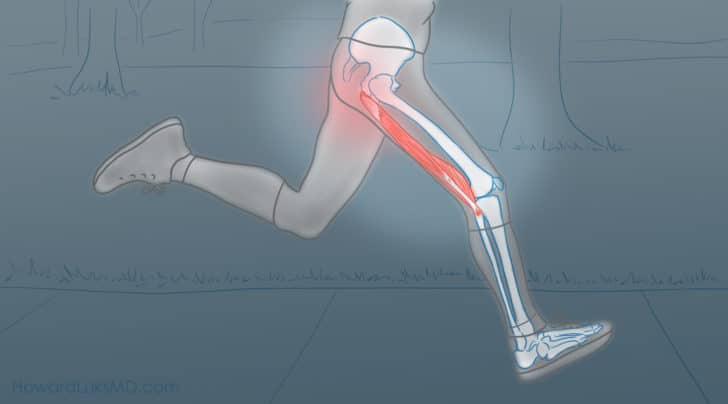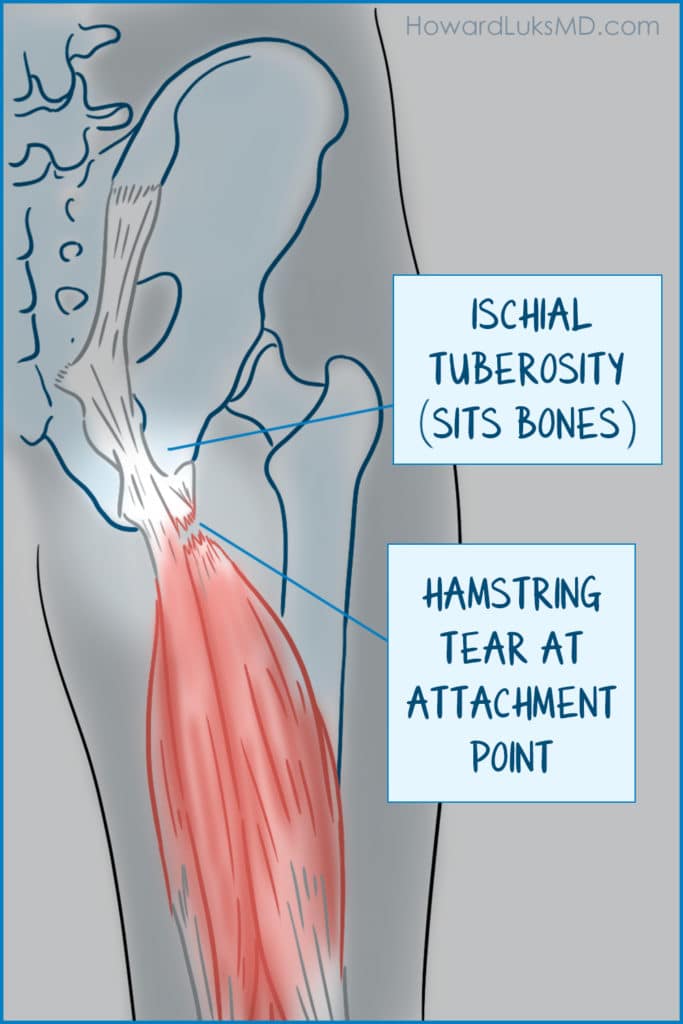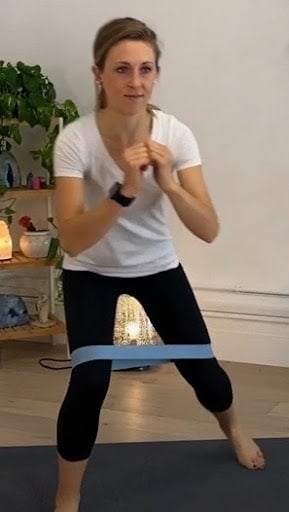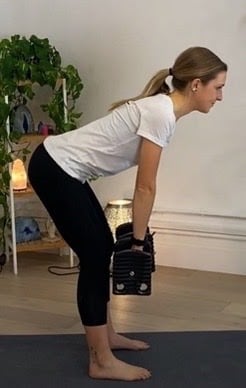
Proximal hamstring tendinopathy (PHT) is one of just a few overuse runners’ injuries that can be quite a bear to manage. It truly is a pain in the butt. You typically only have pain at the beginning of a run and find the pain minimizes as you keep going… but the pain when you sit, drive, and perform specific exercises can be miserable.
Unfortunately, we often bring PHT on ourselves. As we will elaborate later, like many other overuse runners’ injuries, most cases of PHT or high hamstring injury are due to training errors.

Let’s meet the proximal hamstrings.
The hamstrings are a group of three muscles along the posterior aspect of our thigh responsible for extending our hip and flexing our knee. These muscles that cross two joints (hip and the knee)are under a lot of stress throughout the running motion. The hamstrings attach to the pelvis at the ischial tuberosity or the sits bone, and then they progress down the leg to connect to the tibia and fibula.
If we consider the motion of running specifically, our leg is performing both hip extension and knee flexion in the latter part of the stance and initial swing phase – (just after we push off from the ground). This is when the hamstring acts concentrically (or shortening) to produce propulsive power. In addition, the hamstring becomes very active in an eccentric fashion (or lengthening phase) to decelerate the hip and knee during initial contact and loading while running. Because it acts across two joints, the hamstring muscles never stop activating throughout our running or walking cycles.
An injury to the hamstring typically occurs near the musculotendinous junction (where the muscle connects to the tendon) or where the tendon attaches to the bone. In runners, this typically occurs near the proximal attachment point at the ischial tuberosity (the “sits” bone).
What are the Signs/Symptoms of A High Hamstring Injury or proximal hamstring tendinopathy?
A common symptom of high hamstring tendinopathy is a deep dull, occasionally sharp pain or ache near the sits bone (gluteal crease). The ischial tuberosity (sits bone) will be tender to the touch and painful with activity. It can be aggravated by sitting or standing for too long, going up/downstairs, running, jumping, or even walking at times. Other common signs/symptoms of a high hamstring tendon injury include:
- A gradual onset with pain initially felt in the buttock area and slowly radiating further down the back of the thigh.
- Numbness/tingling in the buttock or posterior thigh.
- Discomfort with stretching the hamstring, especially near the “sits bone” attachment.
- Pain that radiates downward into the calf or foot, especially if the sciatic nerve becomes compressed. The sciatic nerve runs right next to the hamstrings. This is thankfully not very common.
The pain should not be bothersome while you sleep or wake you up at night. In addition, this overuse type of tendon injury should not demonstrate much swelling, redness, or bruising. So, if you are experiencing any throbbing pain at night, bruising, or significant swelling, then it is best you consult with a physical therapist or orthopedic doctor to rule out a muscle or tendon tear.

What causes high hamstring Injuries and tedinopathy?
One of the biggest causes of high hamstring tendinopathy or tendonitis is a significant increase in training load/volume or intensity. Hill workouts, track workouts, or running at higher paces more days of the week requires extra compressive forces on the hamstring tendon – especially as your stride becomes longer and as you need more hip flexion to generate power. Hip flexion places more significant compression and shear forces through the proximal hamstring tendon. In addition, an elongated or stretched muscle/tendon that is asked to generate forces quickly is a recipe for strain or musculotendinous injuries. This also explains why poor running mechanics – specifically overstriding- are also a common culprit for high hamstring injuries.
Hamstring Tendinopathy is an overuse injury or training error.
As a runner places repetitive load through the hamstring, micro-tears at the muscle and tendon occur. These microtears are normal and typically don’t lead to injuries if given proper time to heal and recover. However, repeated loading without adequate recovery leads to a disorganized cellular matrix (in the tendon) when the muscle/tendon tries to lay down new tissues and heal.
A common analogy is to think about a pile of pick-up sticks. When you gather the sticks in your hand in an upright position and quickly release your grip, the sticks fall to the table in a very unorganized way. This is essentially what happens at the cellular level. A healthy tendon has all the collagen fibers aligned parallel. In proximal hamstring tendinopathy, the attempt at healing creates an unorganized group of collagen fibers.
Another common analogy is to think about placing a heavy textbook on top of a pile of straws. If you stand the straws vertically but in varying directions, they will not function as a strong unit to hold up the textbook. However, if you align all of the straws in the same direction, they will create enough tensile strength to withstand the load of the textbook. Again – this is the same idea when it comes to tendon fibers. You want them all to align in the same direction to absorb and release energy in a spring-like fashion. Otherwise, the fibers will collapse, leading to injury.

Is it Safe to Run While Recovering from a High Hamstring Injury?
Running with a high hamstring injury can be therapeutic for proper tissue recovery; however, it must be done strategically and intentionally. The most critical first step in recovery is allowing inflammation and pain to subside. This means no visible swelling/bruising and pain that is <2/10 with rest and with regular activity. Some people present with especially “hot” tendons… not hot to the touch, but very, very sore. Running should not be done at this stage. After this hot period, it is ok to start a return to running program.
When you return to running, let pain be your guide at first. Make sure there is little pain during, after, or the following day before you continue attempts at running. In addition, it is more important to increase the volume of running than it is to focus on speed/hills in the initial phases of returning to sport. You’re focusing on healing at this point… not building your lactic acid threshold pace. A great way to assess tolerance to running is to start with walk-runs. A sample “return to run program” could look like this:
- 5 minute walking warm up
- 1 minute of running, 4 minutes of walking
- Repeat above cycles 5-6 times for a total of <30 minute workout
- 5 minute walking cool down
Do this workout every other day for one week and if you remain pain-free, then increase the running intervals by 1 minute (and reduce walking breaks by 1 minute) until you can run for a consecutive 30 minutes. As you are already noticing, this process takes time; however, a slow return to sport is better for your tissues’ longevity and performance. If you are unsure how to return safely, reach out to your physical therapist or other sports medicine provider to reduce any risk of re-injury, as returning to sport too quickly can be risky. Some cases of proximal hamstring tendinopathy can take up to a year or more to resolve.
Best Exercises and Treatment for A High Hamstring Injury
The best way to manage and heal a hamstring injury is by progressive loading, not so much prolonged stretching. In fact, a recent article in 2015 that reviewed the current treatment approach for proximal hamstring tendinopathy found prolonged, static stretching to worsen reported pain levels and promote further tissue degeneration. Instead, contemporary literature supports strategic, progressive loading to rehabilitate a proximal hamstring injury to promote proper fiber realignment, strength, and performance of the hamstring.
Here is an example of progressive loading via exercises:
Do you have questions regarding an Orthopedic injury or longevity?
Do you want to talk to an expert who can listen to you for 45-60 minutes and explain the options in detail?
Dr. Howard Luks offers remote guidance sessions to review your X-ray or MRI images and explain your options.
Dr. Luks has also received hundreds of requests for educational sessions on the topics discussed in his book, Longevity Simplified.
- Hamstring isometrics: In a bridge position or with your hips on the ground, dig the heel of your symptomatic leg into the ground and hold for 10-20 seconds. Perform 5 rounds of these holds and 2-3 sets resting 1 full minute between sets.

2. Hip Thrusters: With your upper back resting against a bench or chair, rest your feet directly underneath your knees and your hips starting on the ground. With or without a weight resting on your hips, slowly push your hips upward toward the ceiling as you squeeze your glutes together. Slowly lower yourself down to the ground. Perform 2-3 sets of 10-15 repetitions, with 1 minute of rest between sets.

3. Banded Glute Walks: With a band above your knees, take forward, and backward steps with your knees slightly bent, and hips shifted backward (i.e., mini squat position). You should feel the outer part of your glutes/hips begin to burn as you continue to take forward and backward steps. Perform 2-3 sets of 10-15 repetitions, with 1 minute of rest between sets

4. Eccentric Deadlifts: Starting in a standing position and holding weights at your hips, slowing hinge from the hips keeping the weights close to your body. There should be a slight bend in your knees and a feeling of “tightness” developing in your hamstrings and calves. Once you reach the middle of your shins, engage your core and squeeze your gluteals to help you return to a standing position. The emphasis is to move slowly through the lowering phase, as a way to gain controlled strength of your hamstrings.

Other exercises that assist with hamstring rehab include Nordic Hamstring curls, squats, dynamic mobility stretching, and plyometric exercises. Due to the complexity of these movements, it is best to consult a physical therapist or personal trainer to assist you through the different phases of hamstring rehab and help you return to sport as safely and quickly as possible. There are risks if you return to sport too early. If you need more ideas for great leg exercises for runners – look here!
Perhaps most important of all… when you start to feel better, don’t go out and push as hard as you were immediately preceding the onset of hamstring symptoms in the first place. Proximal hamstring tendinopathy can be recurrent…
Thank you to my coauthor: Dr. Sarah Ceschin PT, DPT. She is a Physical Therapist in Boulder, CO.












